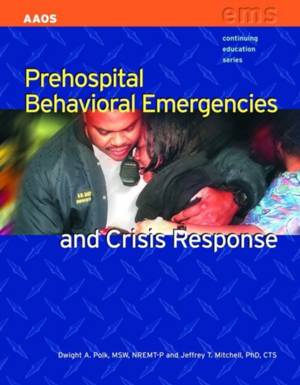
- Afhalen na 1 uur in een winkel met voorraad
- Gratis thuislevering in België vanaf € 30
- Ruim aanbod met 7 miljoen producten
- Afhalen na 1 uur in een winkel met voorraad
- Gratis thuislevering in België vanaf € 30
- Ruim aanbod met 7 miljoen producten
Zoeken
Prehospital Behavioral Emergencies and Crisis Response
American Academy of Orthopaedic Surgeons (Aaos), Dwight A Polk, Jeffrey T Mitchell
Paperback | Engels
€ 127,45
+ 254 punten
Omschrijving
Listen to a podcast with author Dwight Polk.Prehospital Behavioral Emergencies and Crisis Response offers prehospital providers and mental health professionals a comprehensive resource on effectively handling behavioral emergencies ranging from large-scale disasters, to substance-related emergencies, to psychotic disorders. This timely text also provides prehospital providers with suggestions for coping with job-related stress.The text incorporates well-known information-gathering tools such as SAMPLE and OPQRST, as well as two essential new tools for evaluating patients in a behavioral emergency: the SEA-3, a brief and simple assessment tool designed specifically for gathering information about a patient's mental status, and the SAFER-R model, a simple, yet thorough tool designed to help the emergency responder devise a quick and easy treatment plan for helping those in crisis."In the Field" boxes are scattered throughout the chapters and highlight vital information, tips, and best practices that first responders can apply during an emergency call. End-of-chapter material provides vocabulary, chapter summaries, and quizzes that allow the reader to check his or her knowledge and comprehension of the chapter. Important tips for applying concepts to real-life situations first responders encounter in the field, including step-by-step recommendations for conducting assessments.Quiz questions to evaluate students' understanding of the material.Crucial vocabulary that first responders should know when responding to behavioral emergencies.Easy-to-follow methods for quickly evaluating behavioral emergencies using familiar information-gathering tools. Part of our Continuing Education Series; instructors can use the manual and instructor resources for specific classes on behavioral emergencies or as a supplement to existing EMT-B, EMT-I, or paramedic classes. (c) 2009 298 pages
Specificaties
Betrokkenen
- Auteur(s):
- Uitgeverij:
Inhoud
- Aantal bladzijden:
- 298
- Taal:
- Engels
Eigenschappen
- Productcode (EAN):
- 9780763751203
- Verschijningsdatum:
- 23/12/2008
- Uitvoering:
- Paperback
- Formaat:
- Trade paperback (VS)
- Afmetingen:
- 216 mm x 272 mm
- Gewicht:
- 725 g

Alleen bij Standaard Boekhandel
+ 254 punten op je klantenkaart van Standaard Boekhandel
Beoordelingen
We publiceren alleen reviews die voldoen aan de voorwaarden voor reviews. Bekijk onze voorwaarden voor reviews.








